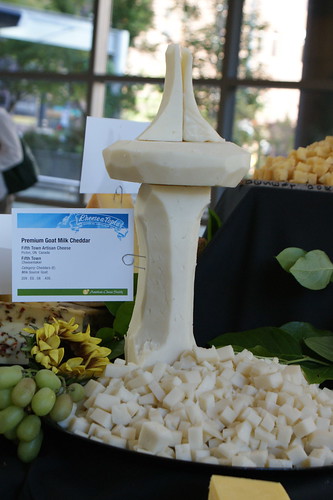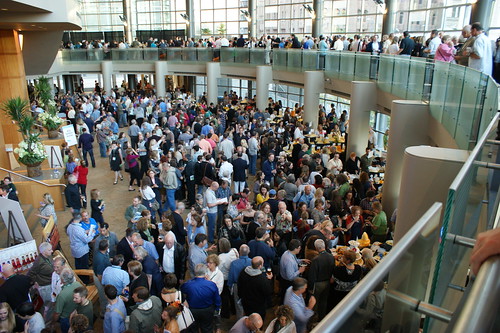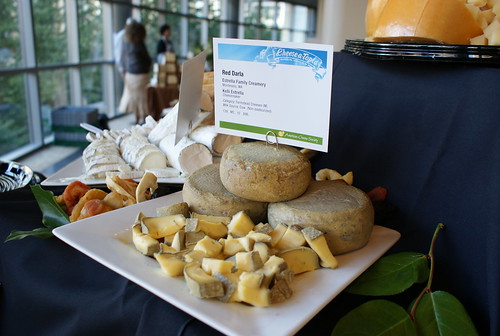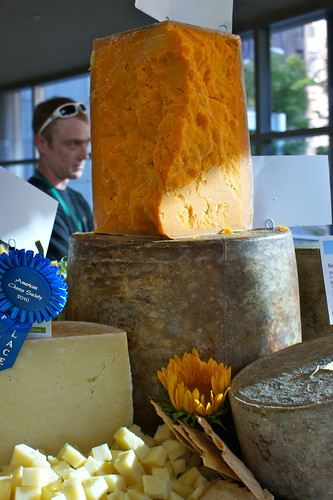ACS 2010 Conference
So, who is ACS and what is this conference? The American Cheese Society claims membership across the U.S., Canada and parts of South America. It’s an organizing body that helps the membership stay on top of trends, studies and industry changes. The conference is an annual event that brings together retailers, cheese makers, farmers, distributors, food scientists and more. The conference has a few events and presents topics of interest to these people. On our tour from Portland to Seattle, we had a few cheese enthusiasts. As an enthusiast, the conference is not really geared towards you. However, the topics are fascinating and with my volunteering hours, I was able to make it to a few seminars. I focused on the two topics that were of interest to me most: business and science. Here’s what I attended:
* * *
Raw Milk Cheese
Catherine Donnelly, PhD., University of Vermont
Dave Potter, Dairy Connection, Inc.
Andre Jean, Health Canada
This was a fascinating seminar on the issues surrounding raw milk and the “60-day rule†which allows cheeses to be made with raw milk if they are aged over 60 days. This naturally rules out soft and mold-ripened cheeses (among other dairy products) that would go bad if left to age 60 days. In France, there is actually a rule that Camembert cannot be legally sold after 57 days. Such a process would be dangerous for soft cheeses.
Why do we care about raw milk? Well, in my layperson’s knowledge of the issue, and after the great talk by Catherine Donnelly: if you want to make high-quality cheese, you need high-quality milk. Pasteurizing the milk does not as a rule make it a poor quality product. You and I, in the U.S., enjoy many amazing cheeses that are made with pasteurized milk. However, pasteurized and raw milk are fundamentally two different kinds of milk.
Pasteurization is a process of heat-treating the milk to a certain temperature for a certain amount of time in order to kill off any nasty bacteria. However, the argument is made, it also kills off the good kinds of bacteria. Bacteria which can also help fight off the organisms which are bad for you. When you start to really get into cheese you will start to become familiar with the fact that it’s not just milk in there giving the cheese it’s flavor. We have to give thanks to all the little microorganisms that live in the milk and create the character of our favorite cheeses. Often, producers need to add back in those microorganisms after the pasteurization process in order to recreate that environment. Dave Potter, one of the speakers, is a purveyor in just such products! Who knew such a thing existed? I didn’t!
The third speaker was Andre Jean from Health Canada who talked about Canada’s approach to the raw milk issue. Basically, it exempts cheese from the pasteurization requirement that it otherwise imposes on fluid (drinkable) milk. In Canada, they are working to develop a set of standards that would apply to different cheese categories – rather than treating all cheeses the same, it would look at issues for hard cheeses, firm, semi-firm, soft, spreadable, etc. And their focus is really on the contamination issue. Pasteurization takes care of organisms at one end of the process but does not do anything to make the cheese super-heroes against contamination through handling later. They feel like education is the key to safe cheese consumption.
It’s worth noting that ACS invited a representative from the FDA to come in and talk about what their stance is on the issue but they declined.
There was lots of great info in this seminar and I found it really illuminating. Catherine Donnelly, from the University of Vermont, is an expert on this topic and a great speaker. If you ever get the chance to hear her speak on this issue, I highly recommend you do it.
* * *
Cheesemaking Demo: Surface-ripened cheese
Marc “Frenchie†Druart, Vermont Institute for Artisan Cheese
Assisted by: Maureen Cunnie, Cowgirl Creamery & Michael B. Vicha, Mt. Townsend Creamery
Okay, I think I have lost my notes on this one! This took place in one of the hotel kitchens around a big vat of already curdled milk where Marc “Frenchie†Druart from the Vermont Institute for Artisan Cheese held forth in a very amusing way on the science behind cheese, specifically surface-ripened cheeses. It involved drawings on the white board of negatively and positively charged molecules, bouncing curds in the sink and checking and re-checking the pH of the milk to know when, just precisely when, is the moment to make your move.
It was almost all over my head but it was really great insight into how things actually get done when you understand the science. I was also rather beside myself to recognize two of my favorite Oregon cheesemakers at the demo taking notes as well. (Fangirl! Squee!)
Ahem.
* * *
Zingtrain – why our dishwashers know our net operating profit
Ari Weinzweig & Aubrey Thomason, Zingerman’s
Zingerman’s is a well-known fine-foods business based out of Ann Arbor. In the process of creating their business and expanding over the years they’ve developed a rather unique approach to doing business encapsulated in the title of the seminar. Basically, everything is open there. Everyone knows how much things cost, how much revenue and profit is being generated and everyone is responsible for taking care of the business. They’ve developed a whole line of training materials and classes to show other entrepreneurs how it’s done. I’ve long had an interest in starting and owning my own business. Hasn’t happened yet but I find the principles of the whole enterprise very interesting. There are so many approaches and we’ve all worked before for a company doing things the wrong way!
This talk was just a quick overview of their business model but it really seems to make a lot of sense. By being open, you are encouraging ownership of the business. When everyone takes ownership, you have a lot of enthusiasm and motivation which is directed toward the bottom line.
They also talked a lot about tracking things – not just numbers (clients, customers, products, revenue, profit) but thing that are harder to quantify like quality. It was really interesting and the idea is something I’ll definitely keep in the back of my mind. I can see this approach working really well in retail industries but I can also see how the principles could be applied in other fields.
* * *
The Enthusiasts Guide to Cheese Science
Zoe Brickley, Cellars at Jasper Hill
I kind of thought this one would be a bit boring. I’m an enthusiast. I’ve read a bit on the science of cheese. I’ve started to get a handle on how things work. I was wrong. I mean, I was right, but also wrong – Zoe Brickley from the Cellars at Jasper Hill took us on a breathless overview of the entire process from grass to cheese and it was totally fascinating. She did an amazing job of breaking down the science into its component parts, offering analogies that made sense and created a narrative that was both informative and entertaining. I also learned a lot I didn’t know about cows! The poor, overlooked cow. We are so concerned about what goes into the cow and what comes out. But the process of what happens in between is pretty interesting and we should not take the happiness and health of the cow for granted.
Also! Jasper Hill makes some exceptional cheese. If you see their stuff anywhere, try it and buy it!
* * *
Festival of Cheese
There were so many more events and seminars and tastings and demos that I did not get a chance to go to. However, as I said before, this is an industry event. It’s really not geared towards the enthusiast despite the last seminar I attended. And it shouldn’t be. From what I understand, dairying, farming and making cheese can be a somewhat isolating career. It’s clear that there is a lot of value in fostering a place for all these amazing artisans to come together and share. The one event that is geared towards everyone with a healthy lactose tolerance is the Festival of Cheese. This was really my whole reason for getting involved in the first place.
On the last day of the conference, they announce the winners of the ACS competition categories of which there are dozens. Then, they put out an amazing spread of all the submitted cheeses – there were over 1400 cheeses submitted this year. 1400, I said!
Here’s a few photos:
Did I try them all? Yes, I did.
No! That’s a total lie; I did not! I would be dead. I gave it my best go, though. Between myself, my husband, and our friends Linnea and Peter, we figured we sampled less than 5% of the available cheeses. We sampled as many of the winners as we could and found some great new cheeses and managed to stuff ourselves silly. It was really a sight (and smell) to behold and so much fun – a truly unique and special bacchanal of cheese the likes of which I can’t imagine seeing again… until next time.
* * *
See more photos of the festival starting here or the whole set of ACS photos.
Don’t miss Part 1, in which we visited three Washington creameries and drank lots of beer at 60 miles an hour.







FUCheese » Three Washington Creameries said,
April 17, 2011 @ 2:09 pm
[…] Next: Part II, the ACS conference and festival of cheese! […]